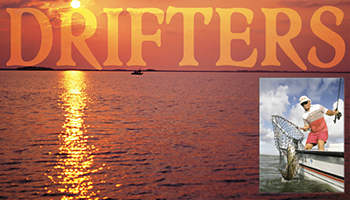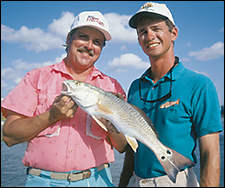
No-nonsense tips for a no-nonsense bay:
The first of a two part series of tips
for fishing Galveston Bay.
By Pat Murray
Green water gushes over
a deep mid-bay reef. The incoming tide surges before a light southeast
wind. Shad and glass minnows quiver on the surface as perfunctory
slicks appear and drift away. You cast diligently, every twitch
of the rod tip sure to entice a strike. Feverishly, you switch
baits again and again.
The day, in essence, is like a paint-by-number John Cowan print.
The tide, the water,
the bait. Everything is perfect. You look to the heavens (as a
tear rolls from behind your polarized glasses) and cry "Why
am I not gettin' 'em?" For many the answer is easy.
You're fishing on Galveston Bay.
Fact is, this is an all
too comon sentiment on the much maligned reefs and shorelines
of the Galveston Bay complex. It needn't be.

Capt. Pat Murray, then a full-time fishing guide on the Galveston Bay System, and TF&G Editor Larry Bozka show off a West Galveston Bay redfish that the duo took while shooting video for the TF&G
Multi-Media Seminar Series back in the spring of 1997.
|
The Galveston Bay Complex is composed
of Trinity, East, West and Lower and Upper Galveston Bays. To
say the least, this is a tremendous amount of bay surface that
is typified by deep water, limited structure and very transient
fish. It's not that there are not plenty of fish or that there
is not an ample number of trophy-class fish. However, the effort
required to consistently catch fish in Galveston is significant.
Blame it on a lack of discernible structure or on overwhelming
fishing pressure or whatever.
The bottom line? Galveston Bay will
sharpen the skills of even the finest coastal angler.
Because of Galveston Bay's predisposition
for deep-water fishing, it is essential that the proficient angler
master his drift fishing skills before all others. With so much
of the bay greater than 4 feet deep, it is only logical that a
large portion of the fish spend an equally large portion of their
lives in deep water.
Learn The Bottom
The first step to improving your drift
fishing is to get a manual depthfinder (10-foot PVC pole). This
sophisticated piece of modern technology transcends the most sophisticated
bottom machine or grayline indicator. There is no need to understand
hieroglyphic directions or read a clouded screen. When you jab
a pole into the bay bottom, you know definitively what the depth
is along with the texture of the bottom.
Through time and persistent jabbing,
you will form an indelible image of the bay bottom that will further
your understanding of what you are drifting over and why fish
are on it. So many times it is the subtle transitions of structure
that hold fish. With a PVC pole, you can feel the transitions
between sand to shell or shell to mud. It gives you the ability
to "walk" the entire bay and visualize the structure
that holds the fish.
Carry A Drift Marker
By simply combining a
white jug, 15 feet of cord, and a 16-ounce snapper weight, you
have a drift marker that is as good a pinpoint as a differential
GPS unit provides. When you catch several fish in a small area,
throw your marker. You
will now have a definitive line-up for a
repeat drift.
The more concentrated
the school of fish, the better the jug works. During winter and
"slow bite" days, a drift marker allows you to concentrate
on tightly bunched schools. If the fish are inactive, the jug
allows you to spend your efforts deciphering what the fish want
rather than blindly drifting over dead spots.
The drift marker also
indicates exactly how you are drifting. Often, it is easy to ignore
the influence of tide in your drift. With a jug, you can calculate
the exact direction of your drift and, subsequently, maximize
your time on a given school of fish.
Ask any experienced pro.
A drift marker can turn a 5-fish day into a 50-fish day.
Use Your Anchor
As ironic as it may sound,
anchoring can greatly improve your drift fishing. Often, you catch
a few fish during a short part of a long drift, yet never stop
on any given spot.
If you hit a group of
fish and repeat drifts successfully on a drift marker, try dropping
the anchor short of "the spot." No, it's not a sure
thing. But when you hit it right, you can sit on top of the school
and maximize your effort on those fish.
continued
page 1 / page 2
| 




